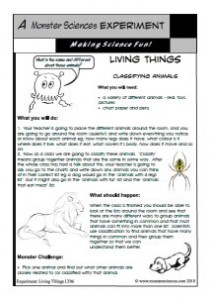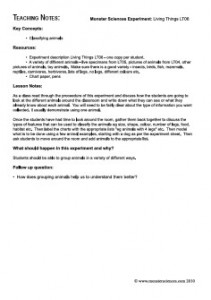An introduction to classifying animals by looking at simple differences between common animals.
 |
 |
What you will need:
• a variety of different animals real, toys, pictures
• chart paper and pens
What you will do:
1. Your teacher is going to place the different animals around the room, and you are going to go around the room (quietly!) and write down everything you notice or know about each animal eg: how many legs does it have, what colour is it, where does it live, what does it eat, what covers it’s body, how does it move and so on.
2. Now as a class we are going to classify these animals. “Classify” means group together animals that are the same in some way. After the whole class has had a talk about this, your teacher is going to ask you go to the charts and write down any animals you can think of in their correct list eg a dog would go in the “animals with 4 legs list”, but it might also go in the “animals with fur” list and the “animals that eat meat” list.
What should happen:
When the class is finished you should be able to look at the lists around the room and see that there are many different ways to group animals that have something in common and that most animals can fit into more than one list. Scientists use classification to find animals that have many things in common and they group them together so that we can understand them better.
Monster Challenge:
• Pick one animal and find out what other animals are closely related to (or classified with) that animal.
Teaching Notes: Monster Sciences Experiment: Living Things LT06
Key Concepts:
• Classifying animals
Resources:
• Experiment description Living Things LT06 – one copy per student.
• A variety of different animals – live specimans from LT05, pictures of animals from LT04, other pictures of animals, toy animals. Make sure there is a good variety – insects, birds, fish, mammals, reptiles, carnivores, herbivores, lots of legs, no legs, different colours etc.
• Chart paper, pens
Lesson Notes:
As a class read through the procedure of this experiment and discuss how the students are going to look at the different animals around the classroom and write down what they can see or what they already know about each animal. You will need to be fairly clear about the type of information you want collected. I usually demonstrate using one animal.
Once the students have had time to look around the room, gather them back together to discuss the types of features that can be used to classify the animals eg size, shape, colour, number of legs, food, habitat etc. Then label the charts with the appropriate lists “eg animals with 4 legs” etc. Then model what is to be done using a few animal examples, starting with a dog as per the experiment sheet. Then ask students to move around the room and add animals to the appropriate list.
What should happen in this experiment and why?
Students should be able to group animals in a variety of different ways.
Follow up question:
• How does grouping animals help us to understand them better?




